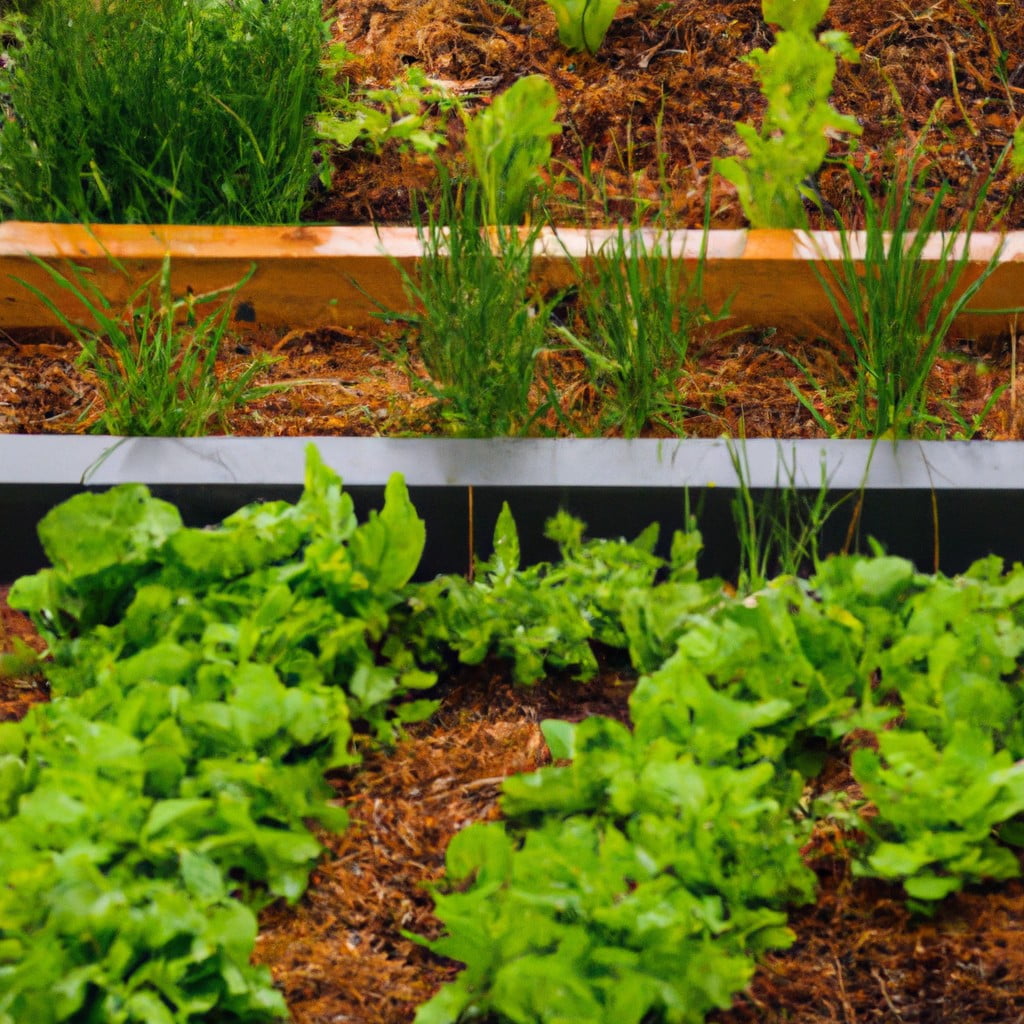Urban farming, a key to achieving sustainability in our cities, reveals remarkable potential for enabling self-sufficiency and food security while mitigating the environmental impact of conventional agriculture.
Urban farming is a revolutionary approach that transforms city landscapes and fosters self-sustainability. It’s an ingenious solution to the increasing demand for fresh, local produce, and it’s also a viable strategy for reducing the carbon footprint associated with transporting food from rural farms to urban markets.
This article delves into the concept of self-sustaining urban farming, discussing its benefits, the various techniques involved, and how to successfully implement them.
Whether you’re a city dweller with a green thumb, a community leader looking for sustainable initiatives, or just curious about urban farming, this comprehensive guide offers insights and practical tips for creating a thriving, self-sustaining urban farm.
Key takeaways:
- Urban farming enables self-sufficiency and reduces environmental impact.
- Self-sustaining urban farming involves diverse crops and resourcefulness.
- Steps for successful urban farming: space selection, soil testing, crop selection, composting, livestock considerations, patience.
- The amount of land required depends on crops and methods.
- Profitable crops for urban farming: culinary herbs, microgreens, specialty mushrooms.
Look Inside:
Understanding Self-Sustaining Urban Farming

To comprehend the essence of self-sustaining urban farming, one must focus on balance and resourcefulness. It involves cultivating a diverse range of crops on small parcels of land scattered throughout the city, often combined with small-scale livestock or poultry keeping.
Farming methods are designed to mimic natural ecosystems to reduce reliance on external resources. This is typically achieved through methods like composting, rainwater harvesting, and companion planting, which enhances agricultural productivity while conserving resources. The aim is to create a self-contained system where waste is minimized by recycling it back into the system.
It can range from a backyard garden to an expansive city rooftop farm. The selection of suitable crops, livestock or poultry, and implementation of efficient farming techniques play vital roles in ensuring the urban farm functions as a self-contained, self-sustaining unit.
Starting With Self-Sustaining Urban Farming: A Step-by-Step Guide
To cultivate a thriving urban farm, consider these steps. First, determine what size and type of urban farm suits your space – this could range from window boxes, rooftop gardens to larger community gardens. Be creative and efficient in space utilization.
Second, perform a soil test to ensure that it’s safe and suitable for planting.
Next, select crops suitable for your climate and soil type. Vegetables like spinach and radish are hardy, and can often be grown year-round in many climates, while fruits like apples and pears need more care and have specific growing seasons.
Invest in high-quality, organic seeds to ensure a healthy yield. Incorporate composting into your urban farm. Composting kitchen scraps creates a nutrient-rich soil ingredient and is a positive step towards achieving the closed-loop system inherent in self-sustaining agriculture.
Consider if you want to incorporate livestock into your farm. Chickens, for instance, can provide not only eggs but also natural pest control. Be sure to check local city ordinances first.
Finally, be patient. Like any farming operation, urban farming takes time to establish and yield results, but with care and commitment, self-sustaining urban farming is an achievable goal.
Amount of Land Required for Self-Sustaining Urban Farming
The space required significantly depends on crop selection and farming techniques. For instance, vertical farming employs a multi-level growing system, thereby reducing the horizontal area needed. Similarly, hydroponic systems, which do not require soil, can optimise the use of space and are suitable for indoor environments such as apartments.
A typical family of four can produce most of its vegetable needs in approximately 700-1,500 square feet, depending on the specific crops grown and the efficiency of the growing methods. It’s crucial to allocate land wisely, diversify food production, and adhere to crop rotation principles to maintain soil fertility in a compact area.
How to Grow Vegetables in Urban Farms
Initially, selecting adaptable species is vital as not all vegetables thrive in urban environments. The quick-growing plants like lettuce, radishes, and spinach are excellent choices. They require minimal space, and can even be grown in containers or vertically.
Furthermore, employing raised bed gardening or container gardening maximizes the use of limited space. These methods can improve soil quality, prevent soil compaction, and control pests more easily.
Lastly, adequate watering is crucial. Though specifics depend on the type of vegetable and local climate conditions, a good rule of thumb is to keep the soil consistently moist, but not waterlogged. Drip irrigation or soaker hoses can efficiently maintain this balance, conserving water by reducing evaporation.
Considering these factors, urban farming can provide an array of vegetables, ensuring access to fresh produce even within city limits.
Raising Animals in an Urban Farm Setting
While the cultivation of crops is a significant aspect of urban farming, incorporating livestock presents an additional dimension of self-sustainability. By selecting suitable animals, you can create a closed-loop system where everything is recycled for a zero-waste setup.
Chickens, for example, are well-suited to urban environments. Not only do they provide eggs, but their droppings can also serve as a rich conditioner for soil, aiding plant growth. Similarly, rabbits can be kept for their meat, and their waste can enrich composts. Bees harnessed for honey production also contribute to the pollination of urban crops.
However, considerations must be taken into account. Ensuring proper care, including regular veterinary visits, is essential for maintaining the wellbeing of the animals. City regulations regarding the keeping of animals should also be referenced to ensure compliance. In several cases, noise and smell pollution needs to be minimally controlled.
Through diversifying your farm’s biological resources, a pragmatic approach to animal care, and abiding by local laws, incorporating animals into your urban farm could offer enriched self-sustainability, enhancing both the productivity and biodiversity of the urban landscape.
Various Land Uses in Self-Sustaining Urban Farming
The concrete jungles of cities offer far more arable land than what one might initially assume. Roof gardens, vertical farming on walls and balconies, revitalized urban spaces such as abandoned lots, and even indoor hydroponic systems are all key players in optimal land usage.
Undoubtedly, rooftop gardens deliver a dual benefit of producing fresh food while simultaneously cooling buildings during the summer. Experimental green walls and balconies display high potential for growing leafy vegetables and herbs vertically, ultimately taking advantage of spatial efficiency.
Then comes the role of vacant urban spaces. These neglected areas, often abandoned or city-owned lots, can be transformed into fruitful garden spots, contributing to city aesthetics, local economy, and community socialization. Lastly, indoor hydroponics—a soilless gardening method—opens up the opportunity for year-round crop cultivation right within our living spaces, regardless of external weather conditions. The entire process, powered by LED growth lights, requires less space and water compared to traditional gardening.
Adapting to these innovative methods, urban farmers demonstrate remarkable ingenuity in exploiting every square foot of city land sustainably for food cultivation.
Advantages and Disadvantages of Self-Sustaining Urban Farming
In terms of advantages, urban farms provide a local source of fresh and healthy food, reducing the energy needed for refrigeration and transportation. Additionally, they promote biodiversity by creating habitats for various species and contribute to local economies through job creation. Importantly, urban farming reduces waste because composting becomes convenient and desirable, which enriches the soil and reduces landfill pressure.
Despite these impactful benefits, challenges exist. Pests and diseases can be hard to control in urban farms due to the close proximity of crops. Limited space may restrict growth of larger crops or most profitable species. Then, there’s the issue of pollution – city soils may be contaminated with heavy metals and industrial pollutants, requiring tests and potentially expensive remediation. Regulatory hurdles might also pose obstacles, as zoning laws and municipal codes may not always be favorable towards urban agricultural practices. Lastly, initial investment for infrastructure could be significant, potentially limiting the accessibility for low-income individuals to start urban farming.
Dealing With Common Problems in Self-Sustaining Urban Farming
One major challenge is limited space, which may be overcome by utilizing vertical gardening techniques, rooftop gardens, or shared community plots.
Light availability can also be an issue in densely built-up areas, and farmers can utilize reflective surfaces or consider crops that require less sunlight to thrive.
Water management is another concern, often addressed by implementing sustainable irrigation systems, rainwater harvesting, and drought-resistant plants.
Soil quality varies and may lack essential nutrients, necessitating the use of composting and other organic enhancement methods.
Lastly, urban pollution may affect quality and health of your crops. Consider regular testing your soil for any adverse elements and make use of barriers or filters.
Regulatory issues can also pose unexpected roadblocks, so always ensure that urban farming ventures comply with local laws and regulations.
Successful urban farming requires thoughtful planning, but the effort will yield a greener, healthier urban environment.
Steps to Establish a Low-Tech Mushroom Urban Farm
To create a low-tech urban mushroom farm, consider these key steps:
1. Selection and Preparation of Space: Mushrooms require a climate-controlled environment. Use basements, unused buildings, or even converted shipping containers. Insulate the space to maintain the required cool, humid conditions.
2. Choosing the Right Mushroom Strain: The mushroom variety should align with your climate and market demand. Oyster and Shiitake are popular choices suited to a broad range of environments.
3. Substrate Preparation: The substrate, the material in which the mushrooms grow, should be full of nutrients. Straw, sawdust, or wood chips are commonly used. The substrate must be pasteurized or sterilized to kill any potentially competing organisms.
4. Inoculation: The prepared substrate is then inoculated with mushroom spawn. It’s essential to maintain a sterile environment in this phase to prevent contamination.
5. Incubation: The inoculated substrate is stored in a dark, warm place to promote mycelium growth. This stage can take 2-4 weeks.
6. Fruiting: Expose the fully-grown mycelium to fresh air, light, and cooler temperatures to encourage it to produce mushrooms.
7. Harvesting: Once the mushrooms mature, they can be harvested by cutting them off at the base. It is best to harvest before the caps fully open.
Following these steps carefully will help ensure a successful first crop of mushrooms in your urban farm. Furthermore, this low-tech approach to mushroom cultivation can be a rewarding and sustainable method for urban food production.
Most Profitable Crops to Grow in Urban Farms
Culinary herbs, microgreens, and specialty mushrooms stand out as highly profitable crops for urban farming due to their high yield per square foot and market demand. Herbs such as basil, chives, and parsley can be harvested multiple times throughout a season, making them a lucrative choice.
Meanwhile, microgreens—tiny versions of vegetables like radish, sunflower, and mustard—reach harvest stage in just two weeks and command a premium price at farmers markets and restaurants.
Finally, specialty mushrooms like shiitake or oyster varieties can be grown indoors on organic waste like coffee grounds, making them ideal for urban farming conditions. The rapid growth and compact growing conditions provide substantial return on investment within the limited space available.
Emphasizing these crops in your urban farming endeavor can significantly boost profitability. Just ensure to research local market trends and consumer preferences to maximize sales potential.
Potential of Urban Household Vegetable Gardens in Reducing Greenhouse Gases
Implementing vegetable gardens within urban households can significantly lower greenhouse gas emissions. This is largely achieved through localized food production, which reduces the need for long-distance transportation and the associated fuel use. By converting sunlight into energy through photosynthesis, plants also absorb carbon dioxide, offsetting emissions.
Moreover, using compost in urban vegetable gardens not only aids in enriching the soil but also aids in reducing methane emissions from landfills. Essentially, kitchen scraps that would have otherwise ended up in landfills are composted, providing rich, nutritious soil for plant growth and acting as a carbon sink. Vegetables can be grown year-round in these gardens, resulting in a continuous cycle of carbon absorption.
Urban household vegetable gardens, therefore, serve a dual purpose: providing fresh, pesticide-free produce for the family while simultaneously contributing to climate change mitigation. Regular maintenance of these gardens, such as proper compost management and using organic pest control methods, further ensures their sustainability and enhances their positive impact.
Savings and Vegetable Output From Community Gardens in Urban Areas
Community gardens significantly contribute to urban food production, offering an impressive yield of vegetables per square foot. Not only do they provide fresh, organic produce, but they also reduce household grocery expenses.
Let’s consider a study conducted by the University of Washington: they found that a 100 square-foot garden plot can produce an annual yield of 200 pounds of produce – about $600 worth on the market. This indicates substantial savings for an urban family, reducing their reliance on supermarket-based foodstuffs.
Moreover, the quality of vegetables grown in community gardens can’t be understated. Growing food locally means you have full control over the presence of chemicals and the harvesting time, ensuring optimal ripeness and nutrient content.
Cost Considerations and Opportunities in Urban Gardening
While start-up expenses for an urban garden might be slightly daunting, the long-term savings can be substantial. Key costs involved include acquiring land, soil testing and amendments, purchasing seeds and plants, and setting up a water system.
Over time, produced food offsets the cost of buying vegetables and fruits from the grocery store. Maximizing the output through multi-crop planning can further increase savings. Moreover, urban gardening presents opportunities beyond cost, such as improving nutritional value and self-sufficiency, adding to the holistic value of the investment.
Converting underused spaces like rooftops into productive land might also offset costs and potentially even generate income. Lastly, city-wide programs and grants exist in many communities reducing the financial burden, further making urban farming more proximately rewarding.
Home-Grown Practices: Motivations and Techniques in Urban Vegetable Production
Emphasis is increasingly being placed on consuming home-grown vegetables. This trend, driven by motivations including food safety concerns, financial savings, environmental considerations, and a desire to connect with the natural world, has been especially observed in urban environments.
Various techniques have emerged to make urban vegetable gardening more feasible and efficient. Vertical farming, for example, offers a solution to limited space by allowing plants to be grown upwards on walls or stacked levels. Raised-bed gardening provides an option to densely plant a wide variety of vegetables in controlled soil conditions, while container gardening offers the flexibility of relocating the garden depending on sun exposure.
Key to successful urban vegetable production is ensuring a rich and fertile soil. Composting organic kitchen waste such as fruit peels, coffee grounds, and vegetable scraps can produce nutrient-rich compost that enriches the soil and promotes healthy plant growth. Implementing crop rotation and companion planting can additionally help in preventing disease outbreak, controlling pests, and maintaining soil fertility.
Technological interventions have also emerged as important tools in urban vegetable gardening. Drip irrigation systems, for example, can conserve water while ensuring consistent hydration for plants. Smartphone apps can simplify the tracking of watering schedules, temperature, and sunlight exposure, allowing urban gardeners to optimize growth conditions.
With commitment and the right techniques, urban dwellers can overcome challenges and succeed in home vegetable production, contributing toward food security and sustainable living.
The Emerging Trend of Local Food Practices: A Case Study of Philadelphia
Philadelphia has seen a dramatic shift towards locally produced food, largely driven by an appreciation for fresh produce and environmental consciousness. This transition is evident in the increasing number of urban farms, farmer’s markets, and farm-to-table restaurants in the city. The urban farms range from small rooftop gardens to large-scale operations covering several blocks, showcasing an array of farming techniques to optimize production in confined space.
A notable instance is the Guild House West, a seniors’ home that transformed their unused rooftop into a productive garden. The residents participate in gardening activities, and they enjoy fresh, organically grown food harvested on-site.
Furthermore, organizations like the Pennsylvania Horticultural Society have launched initiatives like City Harvest, connecting urban farmers with the resources they need, offering horticultural guidance, and facilitating distribution of excess produce to food banks and community organizations. This not only promotes self-sustenance and healthy eating but also strengthens the sense of community.
Overall, the surge in local food practices in Philadelphia illustrates the scalability and adaptability of urban farming, providing valuable lessons for cities worldwide.
FAQ
Is urban farming sustainable?
Urban farming presents a sustainable solution by offering environmental, economic, and social benefits including reduced transportation costs, minimization of runoff during heavy rainfall, and improvement of air quality.
What is a self sustaining farm?
A self-sustaining farm is an agricultural system that is largely independent, producing the majority, if not all, of its food requirements on its own property without relying on external inputs or assistance.
Can you make a living off urban farming?
Yes, it is possible to make a living from urban farming due to factors such as easy market accessibility, low initial and overhead costs, excellent growth conditions, and access to sufficient water while still having less competition from indigenous plant species.
How big of a farm would you need to sustain yourself?
To be self-sufficient, it is generally agreed that a minimum of five acres of land per person is necessary.
What are the most significant benefits of implementing regenerative farming in urban settings?
Regenerative farming in urban settings dramatically enhances local biodiversity, sequesters carbon, reduces dependency on transportation of produce, and strengthens local food security.
How does aquaponics contribute to the advancement of urban farming sustainability?
Aquaponics contributes to the advancement of urban farming sustainability by creating a self-sustaining ecosystem where fish and plants mutually benefit, thus maximizing resource-use efficiency and reducing waste generation.
What strategies can urban farmers employ to enhance the productivity and ecological balance on their farms?
Urban farmers can enhance productivity and ecological balance by using techniques such as vertical farming, permaculture, rooftop gardening, and incorporating aquaponics or hydroponics, whilst also employing strategies like composting and rainwater harvesting to maximize resources and minimize waste.




